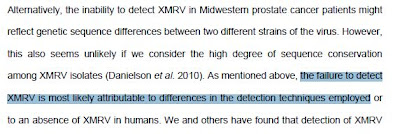Wednesday, July 13, 2011
The failure to detect XMRV in patients is attributable to differences in the detection techniques employed
Maria Barton, August, 2011:
Our screen of patients with prostate cancer suggests the presence of XMRV among patients with prostate cancer in Northeast United States, in contrast to results of some other Midwestern groups (Sakuma et al. 2011). This could be due to geographical distribution of the virus as seen in the past with other human retroviruses that cause cancer (de Rivera et al. 1995) but more likely reflects differences in the methods used. Alternatively, the inability to detect XMRV in Midwestern prostate cancer patients might reflect genetic sequence differences between two different strains of the virus. However, this also seems unlikely if we consider the high degree of sequence conservation among XMRV isolates (Danielson et al. 2010). As mentioned above, the failure to detect XMRV is most likely attributable to differences in the detection techniques employed or to an absence of XMRV in humans. We and others have found that detection of XMRV required rather specific conditions (data not shown). For example, the PCR assay amplifying the gag region is less sensitive than the PCR assay for env sequences.
Also, the inability to detect XMRV in prostate patient samples may indicate that XMRV is sometimes present as an incomplete provirus in the cells of these patients.
The need for highly sensitive assays to detect XMRV is more evident with our results suggesting that XMRV is present at a very low copy number.
Read more>>
Subscribe to:
Post Comments (Atom)


No comments:
Post a Comment